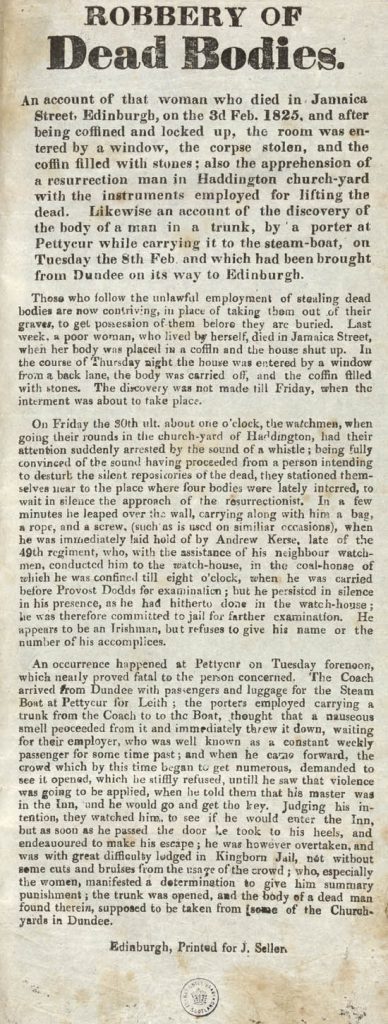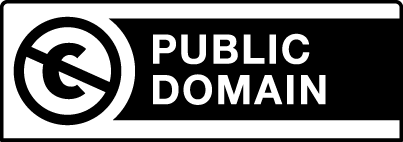Corrected transcriptions
1,727 ALTO XML files at page level
1,727 image files
METS metadata files at item level
142,148 lines and 972,315 words
Covers period 1650-1910
This dataset comprises nearly 1,800 broadsides printed in Scotland. They have been acquired by the National Library since 1925; many of them form part of the Lauriston Castle Collection, which was bequeathed to the Library in 1926.
Broadsides are single sheet items printed on one side only; they were designed to be read unfolded and posted up in public places. They were originally used for the printing of royal proclamations, acts, and official notices. From the second half of the 17th century onwards they became a format widely used for political agitation and were an essential part of printed popular culture, reporting on current hot topics of conversation and scandalous events, such as: violent crimes, the trial and scaffold speeches of convicted criminals, prize fights, mysterious apparitions etc. They also reproduced the words of popular ballads.
Most broadsides cost one penny which was just about within the means of most working people, whereas quality prints at an average of 2s 6d each were well beyond the means of the working class and even lower middle class artisans. Many of the printers who produced broadsides would also have printed other kinds of ‘street literature’ such as chapbooks, tracts, playbills and garlands (collection of love songs in pamphlet form).
Broadsides were mainly pages of text, but occasionally illustrations were added to grab attention. Generally illustrations were made with crude woodcuts, used again and again. In many cases, the illustration bore little or no relation to the text. Although many 18th-century woodblocks were still in use, the more refined process of wood-engraving was being adopted by the early 19th century. This advancement in the illustrative process – together with the mechanisation of printing – made images increasingly available to a wider public. Printers of broadsides worked on the assumption that the more and the bigger the images they could put on a sheet, the more copies they would sell.
Sometimes the printers distributed their own wares, but they relied to a great extent on pedlars, hawkers, street criers and chapmen, who played a very important role in the commercial life of the country 200 years ago. Hawkers would buy broadsides from the printers in urban centres like Glasgow, Edinburgh, Falkirk and Stirling. They would sing and shout about the latest publication on the streets or carry them to markets and fairs throughout Scotland.
The mechanisation of the printing industry in the early 19th century saw a phenomenal increase in the output of all types of street literature, including broadsides. However by the middle of the century, the cheap newspaper and latterly the ‘penny dreadful’ (sensational novels) were beginning to take over from broadsides and other forms of street literature. Newspapers, which had been around since the mid-17th century, became increasingly important as working-class reading, and, thanks to the reduction and eventual abolition of stamp duty on newspapers in 1855, they became more affordable to an increasingly literate population. Moreover, the mass-circulation newspapers and periodicals set a premium on accurate and first-hand visual reporting. Their readership was no longer willing to accept the often sensationalised and slipshod work of the broadside printers, so broadsides disappeared as a popular printed format in the second half of the 19th century.

Visit the Library’s website for the image gallery and website featuring this collection, also known as ‘Word on the Street’: Word on the Street website
Rights information
Broadsides printed in Scotland: up to 1854

Items in this collection up to 1854, and some later items, are free of known copyright restrictions. For details visit the Library’s copyright page.
Broadsides printed in Scotland: 1855 onwards

Items in this collection from 1855 are likely to be free of known copyright restrictions. For details visit our copyright page.
Download the data
Trial the data
Download a sample of the dataset for initial evaluation.
File contents: 1 plain text readme file; 5 ALTO XML files; 5 METS files; 5 image files.
File size: 883 KB compressed (1.38 MB uncompressed)
All the data
File contents: 1 plain text readme file; 1 CSV inventory file; 1,727 ALTO XML files; 1,727 METS files; 1,727 image files.
File size: 284.1 MB compressed (422.0 MB uncompressed)
Caution: large dataset
Just the text
File contents: 1 plain text readme file; 1 CSV inventory file; 1,726 plain text files.
File size: 2.86 MB compressed (5.49 MB uncompressed)
Cite the data
DOI: https://doi.org/10.34812/a272-9961
Dataset creator: National Library of Scotland
Dataset publisher: National Library of Scotland
Publication year: 2020
Suggested citation: National Library of Scotland. Broadsides printed in Scotland 1650-1910. National Library of Scotland, 2020. https://doi.org/10.34812/a272-9961